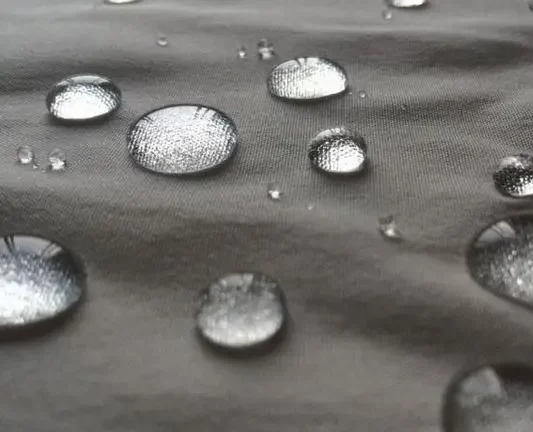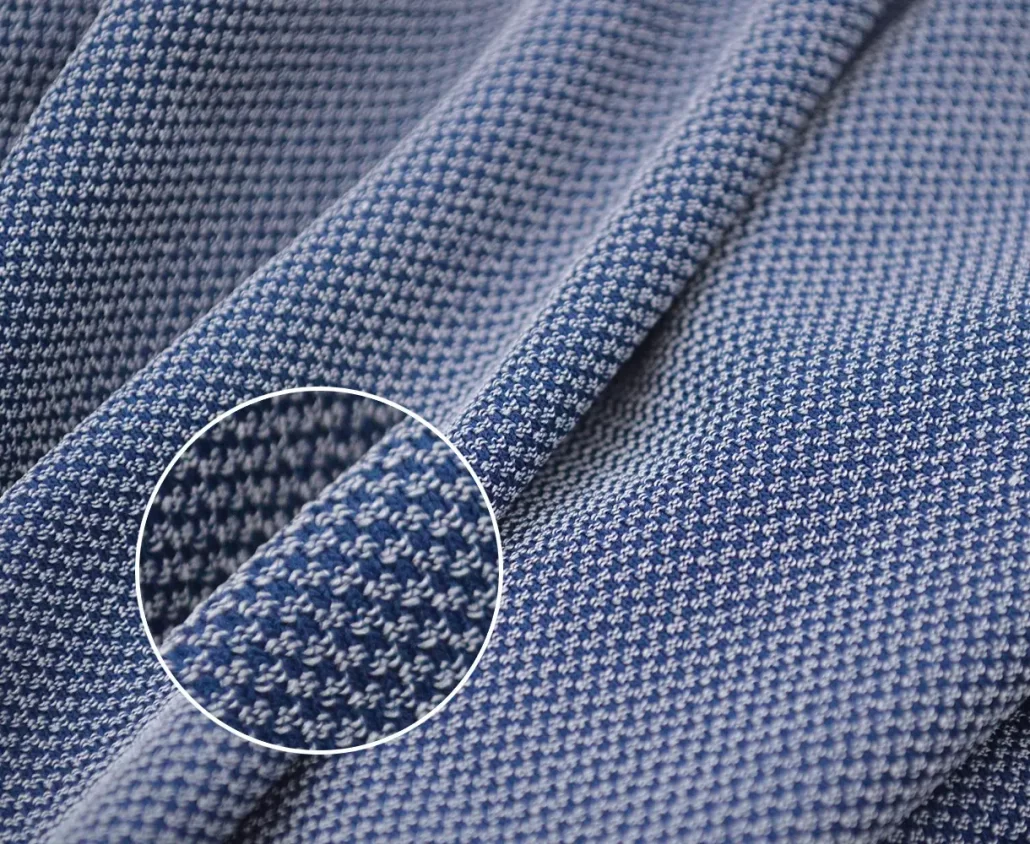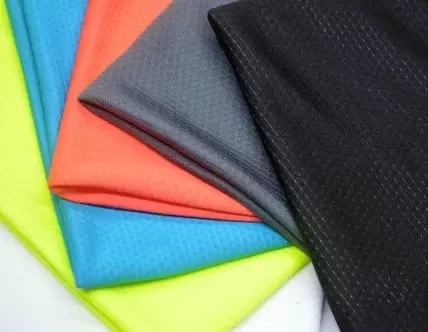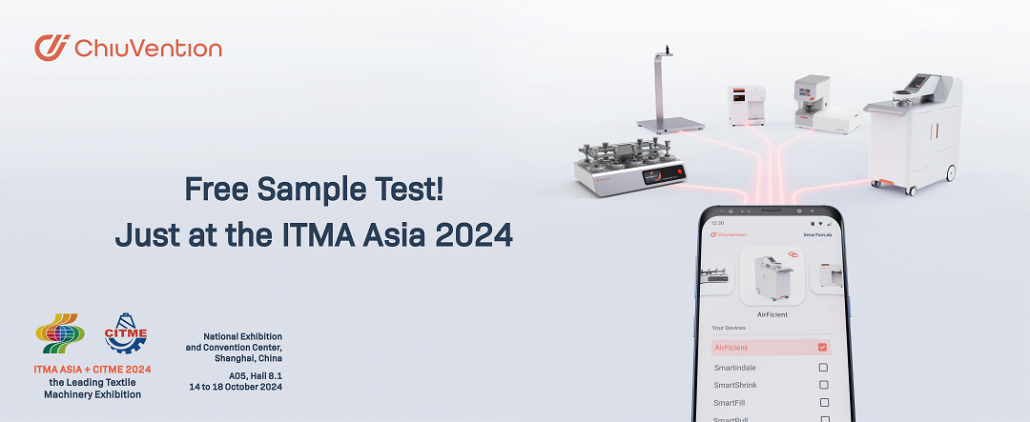Unidirectional moisture-conducting fabrics can effectively export sweat in one direction. They help keep the body dry and cool, especially when playing outdoor sports in autumn and winter. This avoids heat loss from sweating.
1 What is unidirectional moisture transfer?
Unidirectional moisture transfer is a process. It lets the inner fabric, in contact with the body, quickly transfer sweat to the outer fabric. The outer fabric can then quickly evaporate the perspiration.
Two conditions required for unidirectional moisture conduction:
1.The inner layer of the fabric has a good gross effect tube effect;
2. The outer layer of the fabric has a good diffusion effect on the moisture.
2 Unidirectional moisture-conducting fabric application range
Sportswear: Unidirectional moisture-conducting fabrics are often used in sportswear, like sports T-shirts and running pants. They help to quickly move sweat from the skin to the outer layer. This keeps athletes dry and comfortable.
Underwear: It’s used in intimate apparel, especially women’s. It uses moisture-wicking tech to reduce moisture. This improves comfort and hygiene.
Outdoor equipment, like jackets and ski suits, improves comfort in extreme weather. It does this by quickly wicking away moisture.
Medical and Nursing Products: Used to make some medical garments and bedding. They help keep patients dry and prevent skin problems.
Workwear: for professionals in high humidity environments. The moisture transfer function enhances comfort and efficiency.
Sleeping products, like moisture-conducting sheets and pillowcases, improve sleep. They also keep skin dry.
3 Unidirectional moisture conduction principle
Unidirectional moisture transfer is a special fabric property. It allows moisture or sweat to move quickly from the skin-contacting layer to the outer layer, where it evaporates. This transfer process is directional. Moisture or perspiration can only move from the inner layer to the outer layer, not the other way around.
Unidirectional moisture transfer fabrics have two layers. They have different hygroscopic properties. The outer layer is hydrophilic, while the inner is mostly hydrophobic. This difference creates a unidirectional moisture transfer effect. Moisture is transferred to the hydrophilic outer layer. It passes through a small part of the hydrophilic inner layer. Then, it evaporates in the outer layer by rapid diffusion.
4 The difference between moisture-conducting quick-drying fabrics and unidirectional moisture-conducting fabrics
Moisture-conducting and quick-drying fabrics
Moisture-conducting, quick-drying fabric increases the evaporation area. This allows sweat on the fabric to quickly diffuse and dry.
Unidirectional moisture-conducting quick-drying fabric
Unidirectional moisture-conducting quick-drying fabric has two layers. The outer layer is hydrophilic. Most of the inner layer is hydrophobic. The fabric transmits some sweat from the inner hydrophilic part to the outer layer. The outer layer then quickly evaporates it.
Most of the hydrophobic inner layer makes the body sweat when using non-stick fabric. The rapid evaporation of moisture from the outer layer then cools the body.
Unidirectional moisture-conducting and quick-drying fabric is a type of smart fabric. It responds to changes in the environment, like human sweat. It automatically drains the sweat to the outer layer of the fabric.
Water droplets on the garment spread quickly. Patterns appear, but the inside stays dry.
Unidirectional moisture-conducting fabrics use a composite double-layer structure. The inner layer quickly conducts water or sweat to the outer layer. This keeps the skin’s surface dry and comfortable. The outer layer must quickly evaporate the exported moisture or sweat. It must also prevent that moisture or sweat from re-entering the fabric’s inner layer. This will achieve unidirectional moisture conduction.
5 Preparation method of unidirectional moisture-conducting textiles
① Raw materials
Different raw materials have varying levels of hydrophilicity and hydrophobicity. So, use hydrophobic materials on the inside and hydrophilic ones on the outside. This lets sweat pass from the inside to the outside and evaporate quickly. The inner material should not be too hygroscopic. Otherwise, it won’t fully discharge sweat. The same raw material can also be modified by fiber, spinning, and other finishing processes. These changes can alter its hygroscopicity and moisture conductivity. For example, isomorphic fiber cross-sections increase the grooves. This creates a capillary effect for moisture absorption and conductivity. A strong twisted yarn can significantly improve moisture conductivity. A hydrophilic or water-repellent finish can also change yarn performance before weaving.
② fabric organisation
A special, 3D mesh can speed up moisture and heat transfer from the inner to the outer layer. The larger the inner mesh, the smaller the outer mesh. Sweat must flow from the inside to the outside to speed up conduction. The outer layer must evaporate quickly to dry.
③Finishing
Finish one side of the fabric to reduce its thermal and moisture resistance. This will enhance heat and moisture transmission, aiding perspiration. For example, printing is used to apply a one-sided finish to the fabric. It uniformly distributes a water-repellent agent on one side. It also controls the agent’s penetration depth. This makes one side of the fabric hydrophilic and the other hydrophobic. Thus, it creates a dual-sided structure. The hydrophobic side of the fabric conducts moisture better than the hydrophilic side. So, sweat moves from the hydrophobic side to the hydrophilic side. It then quickly diffuses and evaporates, keeping the fabric’s inner layer relatively dry.
6 Unidirectional moisture conductivity test method of fabric
A liquid moisture management test can measure the fabric’s one-way transfer index. This index shows how well the fabric conducts moisture in one direction. It refers to the ability of liquid water to transfer from the surface of the fabric to its penetrated inner surface. It is the ratio of the difference in absorbed water on both sides of the fabric to the test time. A higher unidirectional transfer index means the product conducts moisture better.
The Liquid Moisture Management Instrument meets AATCC 195-2020. Its tests assess the moisture transfer properties of textiles.
AATCC 195-2020
AATCC 195-2020 is the US standard for testing textiles. It tests their unidirectional moisture conductivity. The AATCC created it.
Test Principle:
AATCC 195 tests textiles’ moisture management at different levels. It checks their ability to absorb, conduct, diffuse, and evaporate liquid moisture. The test checks the inner layer’s moisture absorption. It also tests the outer layer’s moisture conduction and diffusion.
Evaluation of test results:
AATCC 195 rates textiles on moisture management, using a 1 to 5 scale.
Score 1: Poor moisture conductivity. It is hard to conduct moisture to the outer layer.
Score 3: Average moisture conductivity, suitable for everyday wear.
Score 5: Excellent moisture conductivity, suitable for high-intensity sportswear or functional outdoor fabrics.
Can AATCC 201 and AATCC 195-2020 test fabrics for moisture transfer in one direction?
AATCC 195-2020 is a test standard. It checks the unidirectional moisture transfer function. And it is suitable for testing sportswear and functional fabrics. It tests their moisture absorption, transfer, and diffusion.
AATCC 201: tests the moisture-wicking and quick-drying of fabrics. It is not for testing unidirectional moisture transfer. The focus is on how quickly the fabric dries when wet. It is not on the moisture transfer from the inner to the outer layers.
From 14th to 18th October 2024, please visit ChiuVention’s booth. Please bring fabric samples to test our instruments.
For more information on textile testing methods/standards
or textile testing machines, contact us:
What’s App: +86 180 2511 4082
Tel: +86 769 2329 4842
Fax: +86 769 2329 4860
Email: medium@chiuvention.com



